|
May
8, 2005: Conference Summary
SA'05 marked
a midpoint, I believe, in the transition of the entrepreneurial
space community from a collection of struggling hopefuls to an actual
industry where the surviving companies produce real products and
services for real customers.
Most of the
space transport firms who came to the meeting are focused on the
suborbital space race and many of them have little or no money to
build their dream ships. However, several organizations have raised
significant funding (in the multiple million dollar range), have
hired sizable staffs, and are at an advanced design and/or prototyping
stage.
This is quite
an improvement from just three or four years ago when it seemed
that no one had any money for any kind of project. While we are
still far from a bonanza for private space development, it is quite
impressive to see the drastic rise in the vitality and viability
of the alt.space movement.
There were no
great, surprise announcements at the meeting. Someone said that
the conference displayed a bit of a hangover from the spectacular
developments in 2004. The success of the SpaceShipOne flights and
of the X PRIZE contest brought a huge wave of publicity for the
alternative space world and dramatically raised its credibility.
The passage of a regulatory framework in the US for commercial human
spaceflight was another big surprise of '04 and was considered a
very positive step by most of the attendees of the meeting.
|
In the
aftermath of all this, there is a sense that there are great
possibilities on the horizon but no guarantees.
Space tourism, for example, looks increasingly like a viable
market but until passenger flights actually begin, no one
can be certain of its scope.
Similarly,
the Commercial Space Launch Amendments Act (CSLAA) seems to
provide a solid, workable set of guidelines for commercial
human spaceflight. However, there was the feeling that we
will have to see how it is actually implemented to determine
whether it will boost or hold back a new generation of piloted
rocketships. (There also remains great uncertainly with regard
to the availability and price of insurance for passenger flights.)
|
| Note:
For $100K to $200k a ticket, just a few hundred passengers
a year are needed to support a space tourism industry,
i.e. pay back the development costs and make a profit
for at least two or three companies. If the number of
customers signing up to pay large deposits increases significantly
beyond 250 (the current sum from Space Adventures and
Virgin Galactic), this would be strong positive signal
and could have big ramifications even before a single
paying customer flies to near space. For example, we could
see space transport companies begin to attract investment
from more conventional sources such as venture capital
groups and not have to rely on angel investors and government
grants. |
|
So it will be
interesting to see how all of this plays out. The stage is set and
for the next couple of years the funded companies will focus on
building their vehicles. The real excitement will start in the 2007-2008
time frame when ships start flying.
Henry
for President
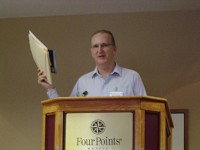
(of
Alt.Space.Org)
Henry Vanderbilt
did a great job as always in organizing and running the meeting.
Thanks Henry!!
An issue that
frequently came up involved the need for an organization to represent
the entrepreneurial space industry and to fight for its priorities
in Washington and elsewhere. I work as a volunteer for the Suborbital
Institute and it will support the struggle but an organization
is needed with a broader base and mandate (suborbital, orbital,
transport, and non-transport). It was emphasized that it would need
a full-time leader who doesn't belong to any of the participating
firms. Someone suggested Henry for such a role and I think he would
be an excellent choice.
Other
Resources
Note that the
meeting was also reported on by Rand Simberg at Transterrestrial
(with input also from Sam Dinkin) and Michael Mealling at Rocketforge.
I link to some of their postings. In addition, the blog Tales
of the Heliosphere
posted comments from the meeting on April
28th and April
29 and provides some photos. The SpaceShow recorded a broadcast
from the conference hosted by David Livingston.
[May.9.05: Jeff
Foust posts part one of his review of the conference: The
post-X Prize hangover - The Space Review - May.9.05.]
[May.16.05:
Jeff Foust posts part two of his review of the conference: Entrepreneurial
space and policy - Space
Review - May.16.05. Also, Charles Pooley posts part of his presentation
on Microlaunchers.]
[May.19.05:
Richard
Treitel has posted detailed
summaries of the talks along with lots of reference links: Trip
Report: Space Access '05.]
Talk
Reviews
I've collected
the commentary and talk reviews that I posted during the meeting
[With some editing here and there]. The following tables group the
presentations into a rough set of categories and the entries are
ordered in the sequence they were given at the meeting. Click on
the speaker name to go to a brief summary of the talk.
| Other Projects/Concepts |
| Organization |
System |
Speaker |
| Stratofox |
Tracking & recovery services
for rocket and balloon programs |
Ian
Kluft |
| The
Rocket Company |
The co-author of the book lays
out the reasons that rocket makers should sell rockets rather
than provide launch services. |
David
Hoerr |
| Astrovision
|
Continuous, live,
high-resolution video of entire world |
Shubber
Ali
|
| Policy/Advocacy/ Regulations |
| Organization
|
Topic |
Speaker |
| Air
Force Research Lab (AFRL) |
Falcon
and ARES
program review. |
Cole
Doupe |
| House Science Committee |
Background of the
CSLAA
and other regulatory issues |
Tim
Hughes |
| AST
|
Implementation of
the CSLAA
|
George
Neld |
| AST
|
Rule making process
|
Michelle
Murray |
| X
PRIZE |
X
PRIZE Cup |
Brooke
Owens |
| Space
Frontier Foundation |
NASA and its relationship with
alt.space firms, advocates, etc. |
Rick
Tumlinson |
| AirLaunch
LLC/t/Space |
Falcon
and ARES
support |
Jim
Muncy |
| JerryPournelle.com |
How to Get to Space: An Irreverent
Guide |
Jerry
Pournelle |
| National
Space Society |
The ISDC
and NSS projects |
George
Whitesides |
| X-Rocket |
Suborbital
Institute |
Ed
Wright |
|
Panel Discussions
|
| Topic |
Members |
| Rocket
entrepreneurs discuss regulations |
Chuck
Lauer , Jeff Greason, John Carmack , John Powell |
| A
Space Startup Investor's Checklist |
Steve Fleming, Joe
Pistritto, Tom Olson |
| The
Challenge of Cheap Orbital Access |
John Jurist,
David Livingston, Sam Dinkin |
| Cheap
Access Politics
|
George Whitesides,
Jim Muncy, Heny Vanderbilt, Rand Simberg |
April
28, 2005
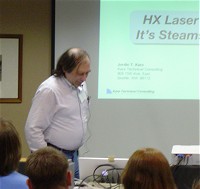
Jordin Kare
11:55
pm: Conference News ... Well, blogging will be a lot
less frequent than I hoped. It just isn't feasible to do it from
the conference room and the breaks are too short with so many interesting
people to talk to. I'll try to do a summary each evening instead.
Here are some highlights of today's meeting....
...
London
to Australia in a flash... Before I start
on the talk reviews, I'd like to report on one interesting
rumor I heard from a reliable source. It appears that
Reaction
Engines, the company led by Alan Bond of Hotol
and Skylon
fame, will receive a multi-year, multi-million euro
contract from the EU, along with some matching funds
from private sources, to support its propulsion R&D.
In particular, they will investigate whether the SABRE
engine technology could allow a passenger vehicle to
fly between London and Australia in just four hours.
In the past
few years, Bond's company Reaction
Engines used private funds to do prototype development of the
key precooler heat exchanger technology. The precooloer lowers
the temperature of air going into a turbojet so that such an engine
can push the Skylon up to Mach 6. (See the precooloer bench
test setup.) The engine would then switch to rocket mode to
go to orbit.
The
LAPCAT project will focus on using this technology to
power a suborbital vehicle for hypersonic long distance
travel.
[Update: I previously
wrote the money will come from ESA but it is actually an EU grant.]
...
...
The conference began with some words from Barbara
Stine, wife of the late G.
Harry Stine who pioneered model rocketry and was also a great
proponent
of alternative access to space. Their son Bill Stine now leads Quest
Aerospace. ...
...
Henry Spencer reviewed issues related
to "Sustainable Spaceflight Beyond LEO". He covered a
lot of topics such as :
- The Moon
is a necessary first stop and "Mars can wait".
- Building
a heavy lift vehicle now would be a waste since it will inevitably
be too small to match the growth of payloads. Might as well learn
to do in-space assembly now.
- He reviewed
a wide range of orbits for earth-Moon operations.
- The north
pole area of the Moon currently looks like the best place to put
a base. There appears to be two or three areas in near constant
light there plus the hydrogen density detected by the Lunar Prospector
is quite high there.
- Mining, e.g.
for water ice if that is the source of the hydrogen, is going
to be really difficult and will require human operators. The dust
is going to be hell on equipment and materials.
...
Wes Kelly of Triton System LLC presented
the Stellar J
rocketplane project. The company will follow a four phase program
beginning with a suborbital demo developed for $20M and eventually
leading to a two stage RLV orbital system for around $400M. However,
he focused less on the technical aspects of the vehicles and more
on the challenges of creating a startup space business and raising
money. ...
...
George
Herbert presented his new Venturer
Aerospace company, which will develop reusable manned capsules
for ELVs. In particular, he wants to fly the capsules on the Falcon
V to capture the
America's Space Prize. He showed two designs that they have
in mind and a R&D program to find the best one and to build
and fly it for around $50M. ...
...
Lt.
Cole Doupe of the Air Force gave an interesting review of the
DARPA/Air Force FALCON
small launcher program, the ARES
RLV first stage/ELV second stage program, and the long term plan
to develop a series of hypersonic vehicles
...
...
Steve
Harrington of Flometrics
gave an update on development of their pistonless
pump, which offers comparable performance to a turbopump but
at a much lower cost....
...
Jordin
Kare gave an optimistic presentation about laser launch. In
his scheme, a large array of low cost diode lasers shines light
on a vehicle with a heat exchanger that converts the beamed power
to heat for the on board fuel. The recent development of fiber lasers
that very efficiently convert the poor quality diode light to single
mode laser light greatly simplifies the beam handling. With this
development, there no longer appears to be any show-stoppers for
laser launch. A one megawatt system could be powering a suborbital
test vehicle within 3-4 years. A 100MW system to put 250 pound payloads
into orbit for $250/lb could be running in ten years. ...
...
There
were three tether related talks. Gerry
Nordley reviewed various projects at Tethers
Unlimited. He showed some cool, high-quality animation of the
launch, deployment, and operation of a momentum
transfer tether system. Henry Cate
talked about "bootstrapping of LEO tethers" and his son
Vincent Cate discussed using rotating
tethers around the Moon to pick up regolith and hurl it to the earth.
...
...
Parker
Bradley of Heron
Aerospace reviewed the fascinating history of long distance
cannons and the attempts to use them as first stage boosters for
rockets. Building on the pioneering work of the 1960s HARP
project, they are working on systems to send small payloads
to orbit at low cost. They are using a Navy
cannon at White Sands to do tests.
11:20
am: News briefs ...
Rand Simberg will be blogging from SA'05 via Transterrestrial
Musings. I assume Sam Dinkin will also be posting his impressions
of the meeting there as well.
April
29, 2005
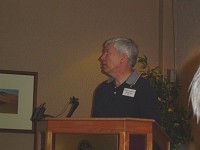
George Neld of
the AST-FAA
11:55
pm: Conference News ... Another intense day of space
access presentations. I'll again give brief reviews of each. As
I mentioned earlier, Rand Simberg [at Transterrestrial]
is blogging many of the sessions. Also, Michael Mealling at Rocketforge
is photo-blogging the meeting. For example, he has documented that
a Flometrics
pistonless pump works extremely well at supplying Margarita
rocket fuel ...
...
One interesting news item of the day came up during Mitchell Burnside
Clapp's talk. He said that he has left Rocketplane
Ltd.
due to "creative differences." He has now reawakened Pioneer
Rocketplane in Colorado and is consulting and developing new
technologies.
Here are short
summaries of the talks. (Very short for those blogged by Rand.)
...
...
The morning session was dedicated
to regulatory issues. (Suborbital
Launch Regulation - Transterrestrial) Tim Hughes, the
majority counsel of the House Science Committee, talked about the
Commercial
Space Launch Amendments Act (CSLAA), which he helped
to push through Congress last year ...
...
Then George Neld, Deputy Associate Administrator
from the AST, reviewed
the situation with suborbital spaceflight and how AST will implement
CSLAA....
[Update -
May.13.05:
Craig
Day of the AIAA
and George announced the release of the
document: Guide
to the Identification of Safety-Critical Hardware Items for Reusable
Launch Vehicle (RLV) Developers. During its development over
two years, AIAA served as the "facilitator" between AST
and an industry working group.
More about the project on the AIAA
- RLV Guide page and in the news release: AIAA
Releases Important Guidelines for RLV Design - AIAA - Apr.29. 05
(pdf).]
...
He
was followed by Michelle Murray, also of AST, who gave a
tutorial on the process by which a guideline becomes a regulation
and how industry and the public can affect the process.
...
...
A panel discussion (see photo at top) with
Chuck
Lauer (Rocketplane
Ltd.), Jeff Greason (XCOR),
John Carmack (Armadillo
Aerospace), and John Powell (JP
Aerospace) talked about the regulatory situation. Basically,
they are happy with AST and the CSLAA process so far. (Regulatory
Panel Discussion-Transterrestrial.)
...
...
Eric Anderson of Space
Adventures was supposed to give the first talk of the early
afternoon session but he canceled at the last minute. So instead
there were some brief substitute talks. (After
Lunch - Transterrestrial)...
...
First,
Tim Bendell introduced the new startup
Frontier
Astronautics, which is specializing in highly reliable, robust
propulsion and attitude control systems.
...
...
Ian Kluft reported on Stratofox,
which provides "tracking and recovery operations for amateur
rocketry and high-altitude balloon ('amateur aerospace') flights"
...
...
Then Rand Simberg, who is currently consulting
with Boeing, presented a CEV concept that Boeing is investigating
that involves commercial delivery of fuel to orbiting depots. This
so-called "dry launch" approach would mean that vehicles
for in-space and lunar transport could be launched without fuel
and so, being lighter, they would not need new heavy lifters. This
would open a great opportunity for the new launch companies to provide
fuel to the depots. ...
...
Jeff Greason reviewed the status
of XCOR. Recently
the company announced that it had won a multi-million dollar contract
with NASA to do R&D for composite fuel tanks. (BTW: XCOR is
now hiring and, in particular, is looking for a composites structures
engineer.) XCOR has not yet raised funding for the suborbital Xerus
development but Jeff is cautiously optimistic. When asked about
the costs, he said it depends a lot on the final design and could
range from $2M to $10M. ...
...
As
mentioned above, Mitchell Burnside Clapp
said that he has left Rocketplane
Ltd.,
and is now with Pioneer Rocketplane in Colorado. He is developing
new concepts and he talked about a new bi-propellant engine design
that takes advantage of the temperature difference between the LOX
and, say, kerosene to drive a heat engine, which in turn drives
a compressor to pressurize the propellants. (Rocketplane
- Transterrestrial) ...
...
Charles
Pooley of Microlaunchers
talked about his small but very inexpensive unmanned vehicles that
could put small payloads into LEO and even send them to Mars. ...
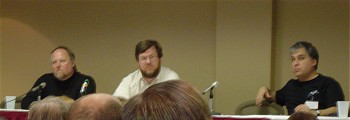
Olson, Fleming,
and Pistritto
...
This was followed by a very interesting panel
discussion on how space startups can raise funding. Steve Fleming
and Joe Pistritto, who were among XCOR's initial investors,
and Tom Olson of The
Colony Fund reviewed the options that entrepreneurs face in
looking for money. They gave lots of useful advice on what to do
and what not to do when trying to sell a company to potential investors.
(Investment
Panel -Transterrestrial ) ...
...
After dinner,
Brooke Owens of the X
PRIZE Foundation showed some entertaining videos of the X PRIZE
and then reported on plans for the X
PRIZE CUP, which will have its first event this October. Currently,
ARCA, Armadillo
Aerospace, the da
Vinci Project, Rocketplane
Ltd.,
Starchaser and
XCOR
have indicated they will carry out demonstration flights at the
exhibition. Rocket competitions won't start until the 2006 or 2007
events. ....
...
David Hoerr,
co-author of The
Rocket Company, presented ideas from the book and focused
in particular on the proposal that rocket builders should sell vehicles
to other companies and let those firms do launch services. That
is, follow the model of Boeing and Airbus, who build planes and
sell them to other companies that specialize in flying passengers.
Such an approach lets each company specialize in what it does best
and spreads the financial burden....
...
Pat
Bahn gave an update on the status of TGV
Rockets. He says the company, based in Norman, Oklahoma, now
has 15 employees and should be ready in May for a preliminary design
review of their VTOL suborbital rocket. The plan is to fly by early
2008. They have spent about $10M so far and expect to spend about
$100M. They have sold two vehicles to government customers and this
money has made the company "cash flow positive". They
are avoiding passenger service due to fears over liability issues
and instead are focusing on military applications, science and technology
payloads, and microsatellite launch (via an expendable second stage.)
[Update May.4.05:
Pat sent this clarification today: "When I use the phrase, "I sold
a rocket", it is in reference to selling a development program,
not necessarily a specific tail number to a specific customer. We
are working towards flight hardware but are working on design only
at this time"] ...
...
The session ended with a panel consisting
of John
Jurist, David
Livingston, and Sam
Dinkin who presented the results of their paper
that estimates the minimum cost of launching payloads to orbit.
There was a spirited discussion of why range services and insurance
are so expensive (these two items dominate the launch costs) and
how they can be reduced.
5:15
pm: Conference briefs ... Rand Simberg has real-time
blogged most of the presentations today. See Transterrestrial
Musings.
I will post
some comments about the presentations later tonight.
April
30, 2005
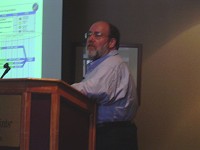
Jim Muncy
(Posted
May 2) 1:15 am: Conference News ... The last day
of the conference included several presentations about companies
with exciting projects in development. There were also sessions
dealing with politics and with the strategies needed to promote
commercial space.
As on the previous
days, both Rand Simberg at Transterrestrial
and Michael Mealling at Rocketforge
blogged the sessions.
Here are short
summaries of each of the presentations:
...
John
Powell of JP
Aerospace gave the status of the organization's many near
space projects. He showed photos and videos of their huge air
ships line such as the Ascender
175.
They hope to
send an air ship to as high as 200k ft. (A Japanese group is also
aiming for this altitude.)
The company
has been working the past few years with an Air Force contract but
he did not discuss the current status of their AF projects. He did
say that the organization has always had each vehicle project funded
by a customer.
JP Aerospace
also launches sounding rockets. They will begin testing the deployment
of Mach Gliders, i.e. V-shaped airships, which are tightly
packed into the nose cones of their rockets and then released and
inflated.
The long term
goal remains development of a airship that can go from a high altitude
Dark
Sky Station all the way
to orbit. JP said they currently believe they can achieve this
seven years from now. However, as before, he did not give any information
about the technology/techniques/magic that would make the scheme
feasible.
Thousands of
students have participated in the PongSats
program and JPA plans to offer it to many more students. ...
...
Len
Cormier gave an update on his design of the Space Van 2009
(see last year's Space
Van 2008 slides.) A huge wing span allows the first stage to
reach 42km where it releases a second stage spaceplane. ...
...
Chuck
Lauer gave a status report on Rocketplane
Ltd. The company obtained private funding of ~$30M along with
~$10M from selling tax credits that it won from the state of Oklahoma.
They have 25 employees at their facility in Oklahoma, where they
are in the process of converting a Learjet into a spaceplane. It
will have new wings and a new tail plus a rocket engine. The jet
engines remain for use in a powered landing.
They recently
completed a preliminary design review and expect to have their critical
design review in August. First flight is planned for early 2007.
More in Rocketplane
(Take Two) - Transterrestrial Musings..
...
I
won't attempt to improve on Rand's description of Rick
Tumlinson's talk: Reverend
Rick - Transterrestrial Musings ...
...
David
Masten reported on the status and plans for Masten
Space Systems. Their goal is to develop a VTOL vehicle that
can take 100kg to 100km and back. It will execute a powered landing
after slowing down with an air brake. They will aim for a 45 minute
turnaround time. Their target market is the education and science
market. Currently, the firm is concentrating on engine development,
especially ignitors and injectors. (See March
2005 Update.) ...
...
John Carmack began with an entertaining
video of Armadillo
Aerospace's many launches and landings, some of which were less
than elegant. (I believe this video
was also shown at the 2004 SFF meeting.) He reviewed the propulsion
studies and tests carried out by AA over the past few years with
engines that used H2O2 in one way or another and how they came to
decide to concentrate on bi-propellant engines. (See his recent
updates for details.)
They are considering
a vehicle with two gimbaled engines. They are committed to flying
a demo at the XP Cup in October.
A remark that
I found quite interesting dealt with VTOL. He noted that without
really trying hard, they achieved mass ratios in the 4 to 5 range,
whereas Burt Rutan found it very challenging to achieve with his
winged vehicle a much lower mass ratio . ...
...
Jim
Muncy, known widely for his political skills, put on his business
hat and discussed the status of two companies with which he is involved.
First, he reviewed
Air Launch LLC,
which also includes
Gary
Hudson, Bevin McKinney, and David Gump. The company last
year won one of the DARPA Falcon design contracts.
A QuickReach vehicle rides inside a C-17 air transport (actually,
2 vehicles would fit in the C-17) . After dropping form the airplane,
the vehicle fires its LOX/Propane engine
Space
Vector Corporation, also a member of the project, provides a
Falcon
page that lists the advantages of air launch.
Jim then switched
to a description of t/Space,
which is pursuing "a lunar exploration architecture and Crew
Exploration Vehicle (CEV) for affordable Moon expeditions."
It would take advantage of technologies like that developed by Air
Launch, to provide a much lower cost CEV system than usually discussed
by NASA. The slides on their web site's Background
page give many of the details.
Putting his
political hat back on, Jim recommended that the community urge Congress
to increase FY06 funding for the DARPA Falcon project so that two
SLV concepts can proceed to the next phase. He thought the ARES
project should be pushed to "maximize synergies" with
the new commercial suborbital RLVs.
See also Rand's
Afternoon
Session - Transterrestrial Musings and Jim
Muncy's policy and politics update - RocketForge.
... Dennis
Wingo gave a technically detailed review of Orbital
Recovery. The company appears to be on its way to a first launch
in 2008. It will have to be a real mission for a real customer.
He said that two potential customer are currently doing their due
diligence on the project ...
...
David
Anderman of CSI
presented the Lunar
Express scheme for combining a Soyuz available after a mission
to the ISS with a module launched from earth to do a fly-around
of the Moon. This would offer a low cost, quick way to get manned
lunar exploration in gear. (Here's a pdf
about the proposal.) ...
...
Tom
Taylor presented the
Lunar
Transportation Systems scheme for lunar exploration. They have
a complete earth to LEO to the Moon set of spacecraft, all based
on a common set of structures. A crucial aspect of their scheme
is the transport and swapping of fuel tanks. That is, rather than
transferring the fuel, they swap tanks. The organization was formed
by Walter Kistler and Bob Citron, who previously founded SpaceHab
and Kistler Aerospace. ...
...
Shubber
Ali reviewed the status of AstroVision,
which plans to offer "the first live, continuous true color
image stream of the Earth." The initial market is Asian. They
recently signed an agreement with Apple Computer to provide a super
computer cluster that could handle the 25 TBytes of data produced
each day. Ball Aerospace will build the spacecraft and they are
pushing for launch by 2008...
...
Jerry
Pournelle gave a talk entitled "How to Get to Space:
An Irreverent Guide". He reviewed his actions as Newt Gingrich's
science advisor in the early 1990s that led to the DC-X
project. He listed the three essential rules for X projects - no
new technologies, build three vehicles, and push the technology
- and pointed out the ways that NASA projects like the X-33 violated
all of them.
He believes
large prizes, e.g. $10B to whomever establishes a Moon base that
keeps 31 Americans alive for three years, as the best way to get
around NASA roadblocks ...
...
George
Whitesides, head of the National
Space Society, discussed the history of the NSS and how he wants
the organization to contribute to pushing humanity into space. The
ISDC has an
impressive list of interesting speakers,
many from the alt.space community...
...
Ed
Wright of X-Rocket
reviewed the history of the Suborbital
Institute and how it contributed to the passage of the CSLAA.
He suggested new issues to push such as ITAR reform and the purchase
of launch services by NASA and other government agencies. He also
urged an emphasis on how suborbital can contribute to education,
e.g. providing low cost access to space for student projects...
...
The final session - Cheap Access Politics
- was led by a panel consisting of Whitesides, Muncy,
Vanderbilt, and Simberg. Various ideas were suggested
by the panel and also from the audience on how the community can
further the cause of lowering the cost of access to space.
The ideas included:
get ITAR restrictions loosened or dropped entirely, make an alliance
of some kind with the aeronautics people getting de-funded by NASA,
require that 1% of the NASA budget go for commercial launch services,
and organize a broad commercial launch industry group that would
be led by a full-time person who did not work for any of the companies
in the group.
Henry publish
a full list of the ideas in a future update on the Space Access
website. See also Michael's list at Space
Policy discussion of "low hanging fruit" that needs doing - RocketForge
April
27, 2005
8:40
pm: Testing, testing ... Made it to Phoenix and it appears
that I can upload files OK via a free wireless connection available
from the conference hotel. (Kudos to Four Points Sheraton and to
Henry for selecting it). So I will be posting reports during the
meeting. However, I want to do plenty of shmoozing to find out what's
happening in the mad, mad world of alt.space rocketeering. So
expect updates to be random and intermittent.
The first
session starts at 2pm tomorrow.
1:15
pm: News briefs... Off to Phoenix to attend Space
Access '05 so this may be my last update for awhile.
...
...
Sam Dinkin gives his preview
of the SA'05 meeting...
|








